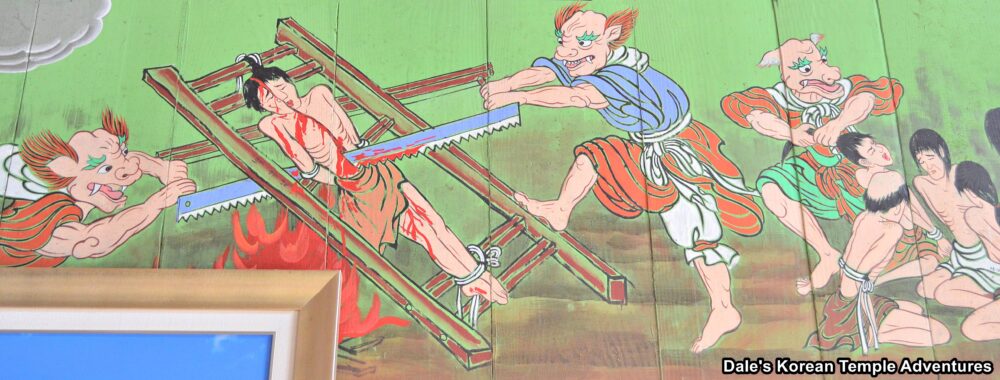Agwi – Hungry Ghosts: 아귀
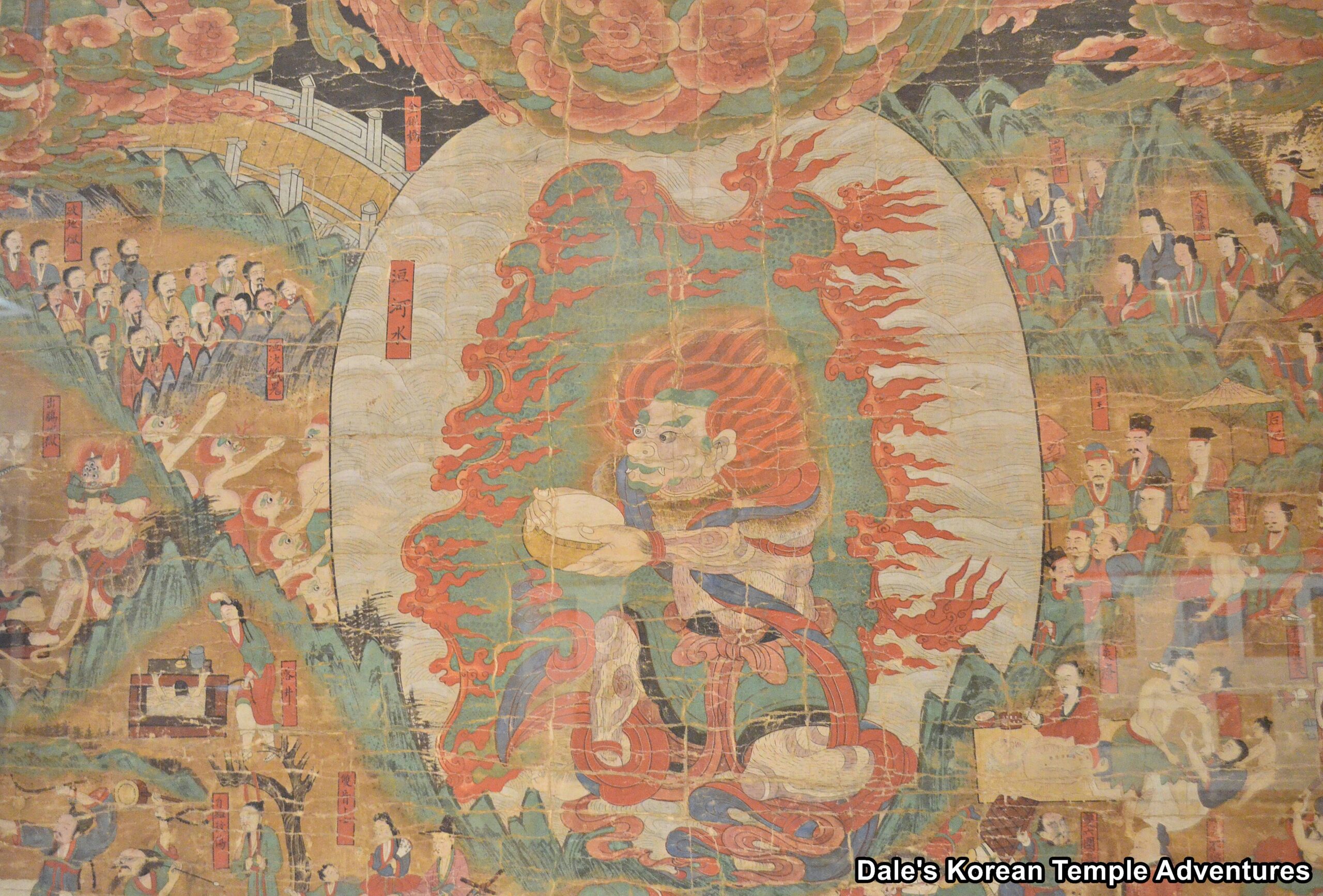
Introduction
Hungry Ghosts appear in Hinduism, Buddhism, Taoism, and local folk religions. They have their origins in Indian religions. Later, Hungry Ghosts were adopted by Buddhism and spread eastward. In Sanskrit, Hungry Ghosts are known as Preta. Preta means “departed or deceased.” And Preta comes from the word “pra-ita,” which literally means “gone forth/departed.” The Chinese translation for Preta is Egui, which means ‘Hungry/Starving Ghost” in English. And Agwi, in Korean, is a transliteration of the Chinese Egui.
What Are Hungry Ghosts (Agwi)?
Most of what we know about the physical description of Agwi (Hungry Ghosts), at least historically, comes from the Saddharmasmṛtyupasthānasūtra (Sūtra of the Foundations of Mindfulness of the True Law), the Zhengfa nianchu jing, which is a mid-6th century Chinese translation from Eastern Wei. This text contains the most detailed description of Hungry Ghosts that exists in the Buddhist tradition of their names, rebirth, physical descriptions, and how many there are. More specifically, this text pays particular attention to the karmic causes leading humans to be reborn as Hungry Ghosts.
Central to the suffering of all Hungry Ghosts is the condition of hunger and thirst and the constant search and inability to alleviate this suffering. Also central is the idea of transition and hope that these Hungry Ghosts create through their quixotic endeavors. According to the Zhengfa nianchu jing, there are two distinct categories of Hungry Ghosts. The first of these categories have Hungry Ghosts living closely with humans. These Hungry Ghosts can be found in the human world and interacting with humans in various ways. The second category has these Hungry Ghosts living in remote parts of the world. Here, they can typically be found in underground regions living in similar conditions as those that reside in hell. They continuously endure torture and punishment
As to who they were in their former lives before they became Hungry Ghosts, these sinners were typically lay people. According to the Zhengfa nianchu jing, they were thieves, bandits, merchants, property owners, donors, and people of higher social status like government officials. The nature of Hungry Ghosts comes from their former sinful lives, so they have a predisposition to commit sinful acts like envy, jealousy, hate, and greed. These are what motivated them before as humans and continues to motivate them now as Hungry Ghosts.
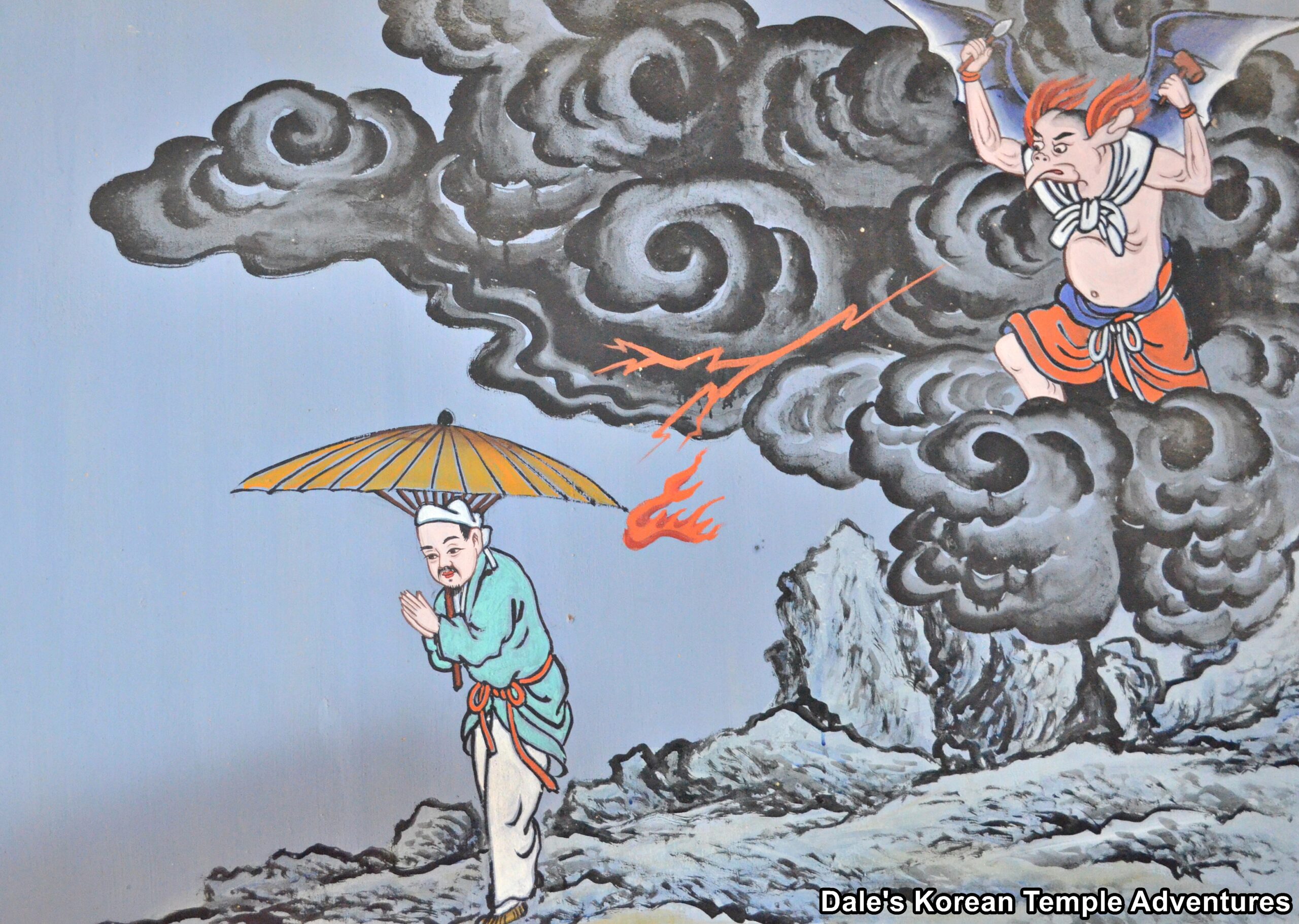
An interesting point to be made, however, is that Hungry Ghosts aren’t motivated by a “purely evil nature;” instead, they’re motivated by need. And the fear that humans have towards Hungry Ghosts isn’t because they’re purely evil; but instead, it’s influenced by the miserable suffering of these sinners. Another interesting feature, which almost seems paradoxical, but Hungry Ghosts like Harmful Conduct Hungry Ghosts, Vital Energy-Eaters Hungry Ghosts, and Assistants of Yama Hungry Ghosts protect and keep the Dharma by reporting the impure acts of humans. And yet, there are other Hungry Ghosts that delight in their incitement of sins by humans.
Interestingly, there are only a few number of evil acts that will bring about a rebirth as a Hungry Ghost. These acts include stealing, failing to give alms, or an action against a monk or Buddhist community. And the act of abstaining from making, stealing, or giving food is central to the damnation of these Hungry Ghosts. And because of their transgressions towards others concerning food, they cannot swallow food, which bursts into flames as soon as it touches a Hungry Ghosts mouth. Furthermore, this suffering is only exacerbated by a Hungry Ghosts inability or difficulty in obtaining food. As for the duration that these Hungry Ghosts have to remain as Agwi, the Zhengfa nianchu jing specifies that one day and one night as a Hungry Ghost is equal to ten years in Jambudvīpa (historic Greater India). As such, these sinners spend 500 years as Hungry Ghosts (so 5,000 years).
A note that needs to be made, however, about the hells that some Hungry Ghosts reside in. These hells are more like the Christian concept of purgatory than that of the Christian hell. These Hungry Ghosts hells are a place for purification to cleanse and absolve a sinner of their past deeds. And in time, these Hungry Ghosts can in fact free themselves of their past misdeeds over a very long period of time. However, this period of time isn’t for eternity. Eventually, a sinner can atone for their sins.
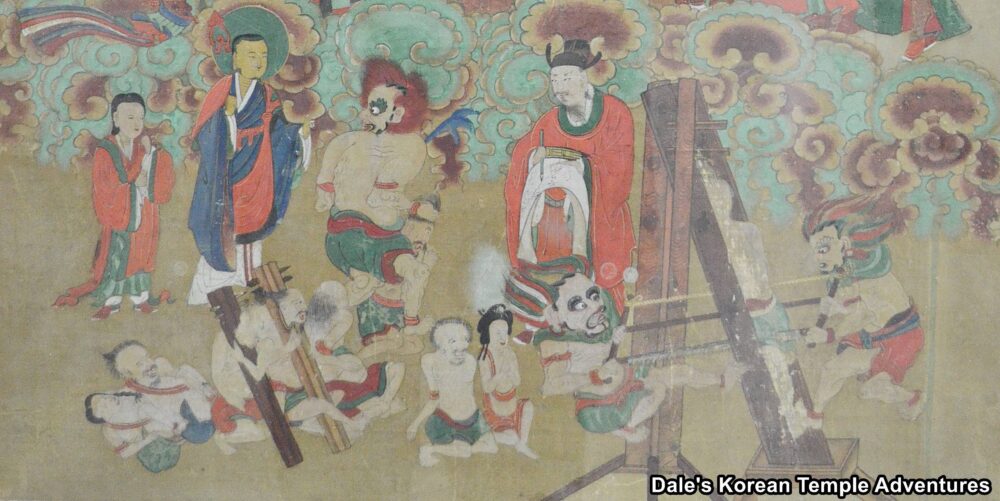
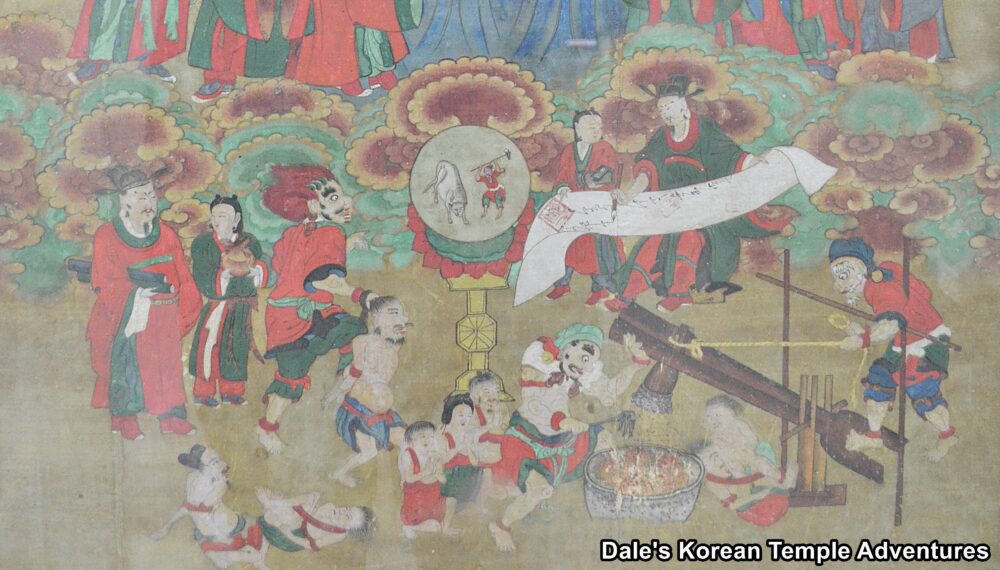
Tales About Hungry Ghosts (Agwi)
There are various sutras and texts that Hungry Ghosts appear in. Here are but a few of the more interesting tales.
One is a rather interesting anecdote that can be found in the third chapter of the Treatise on Discerning Virtue (Fenbie gongde lun). In this chapter, it refers to a story about a group of monks who went to a graveyard to practice “dead body contemplation” (guan sishi). While performing this practice, the monks witnessed something rather odd. They witnessed a Hungry Ghost brutally beating a dead human body. This description is then followed by the corpse in fact being that of the very same Hungry Ghost. The body that the Hungry Ghost is beating once belonged to the very same Hungry Ghost in its past life. By beating its former human body, the Hungry Ghost is unleashing all of its anger against all the weaknesses that it had that led it to become a Hungry Ghost.
Other places you can find tales of Hungry Ghosts are in the “One Hundred Fables Sutra,” which is from the early third century. Here are just a few examples of stories related to Hungry Ghosts and their misdeeds found in this sutra:
One tale from the “One Hundred Fables Sutra” is about a rich man who travels selling sugar cane juice. One day, a monk came to the rich man’s house looking for some juice to help cure his illness. The man had to leave rather abruptly, so the man instructed his wife to give the monk a drink of juice, while he was gone. Instead of doing this, the wife secretly urinated in the monk’s bowl, added a bit of sugar cane juice, and gave it to the monk to drink. The monk was not easily fooled, so he poured out the contents of the bowl. When the wife eventually died, she was reborn as a Hungry Ghost.
Another tale is entitled “An Operation of the Mouth.” In this tale, there is a man who visited his wife’s home. There he saw people removing the husk of the rice. He stole some of this rice and hid it in his mouth. When his wife came to talk to him, instead of opening his mouth and confessing to the rice he had stolen, the husband remained silent. She said, “On his way over, my husband suddenly got a swollen mouth and is unable to speak,” so immediately the wife’s father called a doctor. When the doctor arrived, he said “Very serious is your illness. It will be cured by an operation.” The operation was completed and the husband’s theft was revealed. The conclusion of the tale says, “In doing evil deeds it breaks the pure commandments and hiding sins, people descend to the Three Evil Ways of hell, beasts, and Hungry Ghosts.”
Yet another tale from the “One Hundred Fables Sutra” describes a man who was giving and kind. One day, he was about to leave his house when a monk came begging. The man told his wife to give the monk some food. After the man left the house, his wife was overcome with greed. The wife decided she would teach the monk a lesson, so she locked the monk up inside an empty room all day without food. When she eventually died and was reborn, she was reborn as a Hungry Ghost [Agwi] for an unlimited amount of lifetimes.

The Thirty-Six Different Hungry Ghosts (Agwi)
In total, there are thirty-six distinct Hungry Ghosts. Their names can be connected to where they reside; however, the main way in which they are distinguished is by the food they consume. Furthermore, the distinct name that they have is connected to the specific food they consume. And the food that they typically consume is revolting. Certain Hungry Ghosts live off of humans like a parasite to consume the food they require for existence. Fortunately, most Hungry Ghosts are harmless. In fact, it’s believed that Hungry Ghosts should be pitied instead of feared. Here are the list of the thirty-six hungry ghosts:
1. Cauldron Body Hungry Ghosts 鑊身鬼 迦婆離
Physically, the Cauldron Body Hungry Ghost (Huoshen, Jiapoli) is twice the size of a human, and it has an extremely large stomach. They live a life of suffering and misery because they have extreme hunger; and yet, this hunger is insatiable because it can’t find food. This karmatic situation stems from a rebirth caused by extreme greediness in their former lives. They stole from others or refused to return things to their proper owners.
As for their specific punishment, they are constantly plagued by fire. In some descriptions of the Cauldron Body Hungry Ghost from the Saddharmasmṛtyupasthānasūtra (Sūtra of the Foundations of Mindfulness of the True Law), the Zhengfa nianchu jing, this ghost’s condition is very similar to that of beings in hell. They are confined to a remote and dark region of the universe. In fact, they reside in a world 500 yojana (6400 km) below the earth. These Cauldron Body Hungry Ghosts endure torture similar to those suffering in Samghata (one of the eight hot hells). There, Cauldron Body Hungry Ghosts are continuously crushed between two crumbling mountains.
2. Needle-Mouth Hungry Ghosts 針口鬼 蘇支目佉
Similar to Cauldron Body Hungry Ghosts, Needle-Mouth Hungry Ghosts (Zhenkou, Suzhimuqu) have a huge body, so they require large amounts of food; however, they only have needle sized throats. So even when they find and consume food, it’s extremely difficult for them to swallow this food. This only adds to their overall torment. Their karmatic rebirth as a Hungry Ghost comes as a result of a rich person pretending they were in fact poor, so that they didn’t need to give to charity. Their sin is miserliness/stinginess.
An example found in the Saddharmasmṛtyupasthānasūtra (Sūtra of the Foundations of Mindfulness of the True Law), the Zhengfa nianchu jing, are women who refuse to carry out their husband’s wish to present food offerings to Buddhist monks and Brahmans. These women falsely claim that their family lacks sufficient food.
3. Vomit-Eating Hungry Ghosts 食吐鬼 槃多婆叉
Vomit-Eating Hungry Ghosts (Shitu, Panduopocha) consider human vomit to be a delicacy; and as such, they consume it as food. They desperately roam the world in search of vomit on the ground or on walls. Their suffering comes as a result of their frustration in pursuing food, which is only occasionally released in hard-won moments of satisfaction in finding vomit. Usually harmless, Vomit-Eating Hungry Ghosts attach themselves to people who are known to be heavy drinkers that tend to vomit after bouts of heavy drinking. In time, however, these Hungry Ghosts can become dangerous if they develop an ability to influence weak willed people.
Their karmatic rebirth as a Hungry Ghost comes as a result of people who share “inferior” items with others while keeping “superior” items all to themselves. This is especially true of food or making an offering to charities. An example found in the Saddharmasmṛtyupasthānasūtra (Sūtra of the Foundations of Mindfulness of the True Law), the Zhengfa nianchu jing, are items that are unwanted, yet donated all the same, to temples.
4. Excrement-Eating Hungry Ghosts 食糞鬼 毘師咃
Excrement-Eating Hungry Ghosts (Shifen, Pishituo) usually hang around unclean toilets or places where excrement is discharged. Like Vomiting-Eating Hungry Ghosts, their suffering comes as a result of their frustration in pursuing food, which is only occasionally released in hard-won moments of satisfaction in finding excrement in toilets, on the ground, or on walls. These Hungry Ghosts can cause a feeling of darkness or trepidation around bathrooms and/or toilets. In fact, they can make you feel as though someone is watching you in these private places; when in fact, no one is there. Usually harmless, Excrement-Eating Hungry Ghosts can gain favour and influence over the mind of people who crave drugs. It’s only then that these Hungry Ghosts can become more dangerous.
Their karmatic rebirth is caused by people who had offered unclean food to charity or to religious people. And this unclean food refers to food of substandard quality or spoiled food, so it’s not suitable for consumption or offering. This offering is made with malicious intent. Also, they’ve offered impure food, like the mixing of meat with vegetables to monks; who in turn, commit a transgression by consuming this impure food.
5. Foodless Hungry Ghosts 無食鬼 阿婆叉
Foodless Hungry Ghosts (Wushi, Apocha) are constantly roaming one side of the universe in search of a source of water, wishing to quench the flames burning in their stomachs and destroying their bodies from the inside out. And during their long journey in search of food, it leads them to a plateau, where they eventually find a water source. However, these water sources are protected by guardian demons that don’t allow the Foodless Hungry Ghosts to drink by beating them with sticks.
These Hungry Ghosts are given this karmatic rebirth because they have starved others to death in a former life. They can also be people who have abused power like jailers towards those that are jailed.
6. Odour-Eating Hungry Ghosts 食氣鬼 揵陀
The Odour-Eating Hungry Ghosts (Shiqi, Qiantuo) feed off the smell of food offerings that people make to deities at trees, stones, rivers to ward off disease. These deities specifically refer to any form of religious belief or spiritual practice. And the reason they have been reborn as an Odour-Eating Hungry Ghost is that while they were a husband or wife in their former lives, they didn’t share “excellent foods” with their spouse, children, or family members.
When Odour-Eating Hungry Ghosts are reborn as a human, they can also suffer from various diseases and misfortunes like a short lifespan, birth defects, poverty, and accidents. In general, they suffer from a general lack of support in order to survive. So again, they suffer from hunger, thirst, and deprivation as humans, as they once did as Hungry Ghosts.
7. Dharma-Eating Hungry Ghosts 食法鬼 達摩婆叉
Physically, the Dharma-Eating Hungry Ghosts (Shifa, Damopocha) are disfigured with hollowed eyes. They are also bony and emaciated in appearance. Their veins appear covering their entire body. This appearance is entirely connected to their state of starvation in which they are forced to live their lives deprived of food and constantly being hungry. They are also eaten at by insects. The only way they gain relief and strength is by getting closer to temples and hearing “senior monks” at the temple teaching the Dharma, so they tend to gather around temples during Dharma talks. And the reason for their karmatic rebirth as a Hungry Ghost is that they spread false doctrinal teachings of the Dharma.
8. Water-Eating Hungry Ghosts 食水鬼 婆利藍
Water-Eating Hungry Ghost (Shishui, Polilan) hunt in vain for water. Physically, they have both rigid and dry bodies. They tend to live near drains or the side of a river. They mistakenly perceive water as food. However, because their body is both rigid and dry, they find it hard to consume water. For example, Water-Eating Hungry Ghosts tend to wait by waterways and rush towards droplets of water left in a person’s wake while crossing a river or stream. Otherwise, these Hungry Ghosts can only swallow small amounts of water at one time. The reason for this is that the water slips through their fingers. Additionally, they are constantly followed and tormented by Demon-Guards of the Water (shoushui zhugui).
And the reason for this karmatic rebirth is that they were producers of alcohol who tampered with their products by adding things like worms or insects to corrupt Buddhist believers. As a result, they have lost all sense of their virtue. And when these Water-Eating Hungry Ghosts are reborn as humans, they suffer by living in the fringes of society through geographic disadvantages.
9. Living-On-Hope Hungry Ghosts 悕望鬼 阿賒迦
Living-On-Hope Hungry Ghosts (Xiwang, Ashejia) have extremely hairy bodies. Also, their hair is all disheveled and they have deep wrinkles on their faces. And the only food that they can consume are the offerings made by mourners to honour their deceased parents. As a result, these Hungry Ghosts are attracted to grief and delight in funeral food. In general, Living-On-Hope Hungry Ghosts are usually pretty harmless unless they can influence a person negatively.
And the reason for their karmatic rebirth as a Hungry Ghost is that they profited off the misfortune of others. Another reason is that they took advantage of people facing difficulties by selling goods like food at exorbitant prices.
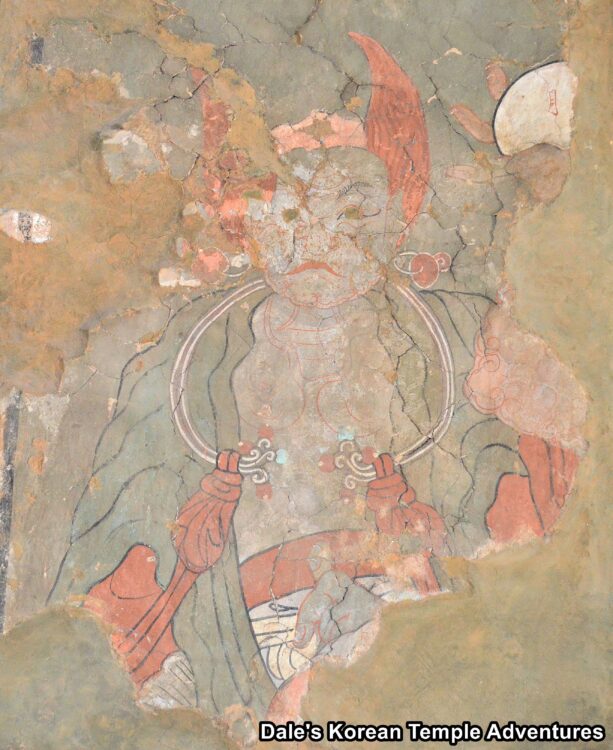
10. Spittle-Eating Hungry Ghosts 食唾鬼 㖉吒
The Spittle-Eating Hungry Ghost (Shituo, Qizha) is similar to the Vomit-Eating Hungry Ghost. The Spittle-Eating Hungry Ghost is attracted to spittle and considers it a delicacy. They tend to follow around people who habitually spit in public places. For this reason, especially in Buddhist countries in Asia, it was considered taboo to spit in public places. Spittle-Eating Hungry Ghosts can also desperately roam the world looking on streets and walls for spit. Their intense suffering is only relieved when they consume spittle. But this relief is fleeting and their hunger quickly returns.
And the reason for this karmatic rebirth as a Hungry Ghost is that they offered impure food to monks who then consumed it similar to Excrement-Eating Hungry Ghosts. And when these Hungry Ghosts are reborn as humans, their general condition is one of misfortune. In general, they lack the means to survive, and they tend to just get by through the assistance of others.
11. Garland-Eating Hungry Ghosts 食鬘鬼 摩羅婆叉
Garland-Eating Hungry Ghosts (Shiman, Moluopocha) have great supernatural powers. They can appear in dreams to frighten people. Garland-Eating Hungry Ghost steal offerings made by believers that were intended for either the Buddha or monks. And while Garland-Eating Hungry Ghosts are attracted to religious offerings, when they possess these offerings, they turn into objects of torment that attach to their bodies. Examples of these offerings can be flowers, religious items, or any other religious offering.
The reason for this karmatic rebirth is that they were caught for stealing from religious places. And while most Hungry Ghosts are meant to be pitied, which they should be, the Garland-Eating Hungry Ghost is considered quite formidable. They have the ability to appear in a person’s dreams and corrupt their minds. And the way they manifest in a person’s dreams is to appear as a deity with flames attached to their body. This is a scamming spirit who appears to be a deity; but in actual fact, only appears in dreams to deceive.
12. Blood-Eating Hungry Ghosts 食血鬼 囉訖吒
Another Hungry Ghost with supernatural powers like the Garland-Eating Hungry Ghost is the Blood-Eating Hungry Ghost (Shixue, Luoqizha). They are attracted to blood and blood sacrifice. Some people mistaken these Hungry Ghosts for deities; and as a result, they make offerings to them and pray to them for personal and material gain.
Nefarious actions that these Hungry Ghosts can lead people to do is to influence a person’s mind to self-harm such as whipping oneself until they bleed. In general, Blood-Eating Hungry Ghosts are considered to be yakṣa (a broad class of nature-spirits, usually benevolent, but sometimes mischievous). And blood is something that nourishes these creatures.
13. Flesh-Eating Hungry Ghosts 食肉鬼 瞢娑婆叉
Fleshing-Eating Hungry Ghosts (Shirou, Mengsuopuocha) are fed by various kinds of animal meat offerings. This Hungry Ghost is similar to the Blood-Eating Hungry Ghost except that these Hungry Ghosts subsist off of raw meat. And the reason for their specific karmatic rebirth is that they were formerly meat-sellers who took advantage of their customers by giving them less than the amount they paid for.
14. Fragrance-Eating Hungry Ghosts 食香煙鬼 蘇揵陀
Fragrance-Eating Hungry Ghosts are attracted to incense and sweet smelling objects. They also possess supernatural powers. They have the ability to fool people into worshiping them. That’s why people can mistakenly offer these Hungry Ghosts incense offerings. And it’s quite easy to mistakenly make offerings to these Fragrance-Eating Hungry Ghosts because it’s simply a state of mind and whether one is in the proper frame of mind to make offerings to Buddhas and Bodhisattvas instead of a Hungry Ghost.
Like Blood-Eating Hungry Ghosts, they too are considered to be yakṣa (a broad class of nature-spirits, usually benevolent, but sometimes mischievous). They commonly reside either in temples or near crossroads. They roam forests and can be seen inside pavilions or on city walls.
And the reason for their karmatic rebirth as Hungry Ghosts is that they were people that sold low quality incense for religious offerings or cheap perfume at high prices in their past lives. However, by indirectly contributing to other people’s merit-making through incense offerings, these people gathered a certain amount of good karma for themselves, as well. So even though they’ve been reborn as a Hungry Ghost, they still have gathered some karma from their former actions.
15. Harmful Conduct Hungry Ghosts 疾行鬼 阿毘遮羅
Harmful Conduct Hungry Ghosts (Jixing, Apizhiluo) feed upon the energy of wicked deeds committed by people. These wicked deeds can manifest in various ways and forms whether they’re religious or non-religious. For example, these Hungry Ghosts can be drawn out by people who perform harmful incantations. More specifically, these Hungry Ghosts target and feed off impurities, especially those that engage in impure conduct. This can be done both in the real world and/or in a person’s dreams. These creatures wander through cemeteries and enjoy the company of dead bodies. They also delight in death and epidemics. Additionally, Harmful Conduct Hungry Ghosts move very quickly and can travel hundreds of thousands of yojana (12.8 km) in a few seconds. They too are powerful yakṣa endowed with supernatural powers.
And the reason for this karmatic rebirth as a Harmful Conduct Hungry Ghost is that these people were once śramaṇa (a person that toils for some higher or religious purpose). These people would go around to villages and encourage people to make offerings for sick people; but instead of giving these donations to the poor, these śramaṇa would keep the donations all to themselves.
16. Hunting Hungry Ghosts 伺便鬼 蚩陀邏
Yet another Hungry Ghost with supernatural powers are the Hunting Hungry Ghosts (Sibian, Chituoluo), who are also known as Looking-For-The-Right Opportunity Hungry Ghosts. Physically, these Hungry Ghosts have hairy bodies, and they are continuously surrounded by flames, so these Hungry Ghosts constantly suffer from being burned. They hunt for an opportunity to negatively influence a person’s mind or by sucking out their energy. However, it’s uncommon for these Hungry Ghosts to be successful. That’s why they are continuously tormented. And the reason that they are so often unsuccessful is that once a person develops a stronger mind through meditation or chanting, they can rid themselves of these Hungry Ghosts. So once these Hunting Hungry Ghosts can no longer feed off of their host, they will simply leave.
When Hunting Hungry Ghosts are reborn as a human, much like the Odour-Eating Hungry Ghost, they can also suffer from various diseases and misfortunes like a short lifespan, birth defects, poverty, and accidents. In general, they suffer from a general lack of support in order to survive. So again, they suffer from hunger, thirst, and deprivation as humans, as they once did as Hungry Ghosts.
17. Underworld Hungry Ghosts 地下鬼 波多羅
An Underworld Hungry Ghosts (Dixia, Buoduoluo) reside in caves and underground places. Here they live with huge snakes and suffer from hunger and the cold. Also, these Hungry Ghosts have the ability to create epidemics. Physically, they look emaciated and have disheveled hair. And the reason for this physical appearance is that it’s a consequence of having extreme thirst.
The reason for their karmatic rebirth as an Underworld Hungry Ghost is that they put a person in jail for personal gain, whether that person was guilty or not was inconsequential to these people.
18. Supernatural Powers Hungry Ghosts 神通鬼 矣利提
Supernatural Powers Hungry Ghost (Shentong, Yiliti), as the name of the Hungry Ghost kind of alludes to, has immense supernatural powers. They live deep in the mountains, in the middle of the sea, coastlines, or remote locations. And while they suffer like other Hungry Ghosts, they seem to suffer less and have a state of relative joy. Oftentimes, people mistake these Hungry Ghosts for deities.
Their punishment is to be surrounded by a large number of demons. Additionally, Supernatural Powers Hungry Ghosts experience pain, and they are constantly being stared at; as a result, they have miserable-looking eyes. And the reason for this karmatic rebirth is that they abused power by stealing other people’s property.
And when they are reborn in human form, Supernatural Powers Hungry Ghost can hold positions of power like rulers or high-ranking ministers. The only problem with these people and their high-ranking positions are that they typically live in a time of drought or famine.
19. Blazing Hungry Ghosts 熾燃鬼 闍婆隸
Blazing Hungry Ghosts (Chiran, Shepoli) suffer from having their bodies on fire. They wander through cities and villages or near mountains and forests. They cry out in pain because of the flames that consume their bodies. They also have a particularly frightening appearance. They tend to frighten people and/or loot villages like destroying city walls, robbing or killing people).
And the reason they have such a terrible karmatic rebirth is that they looted and robbed others in their former lives. This also includes government officials who, after winning the king’s trust, become extremely evil and wicked.
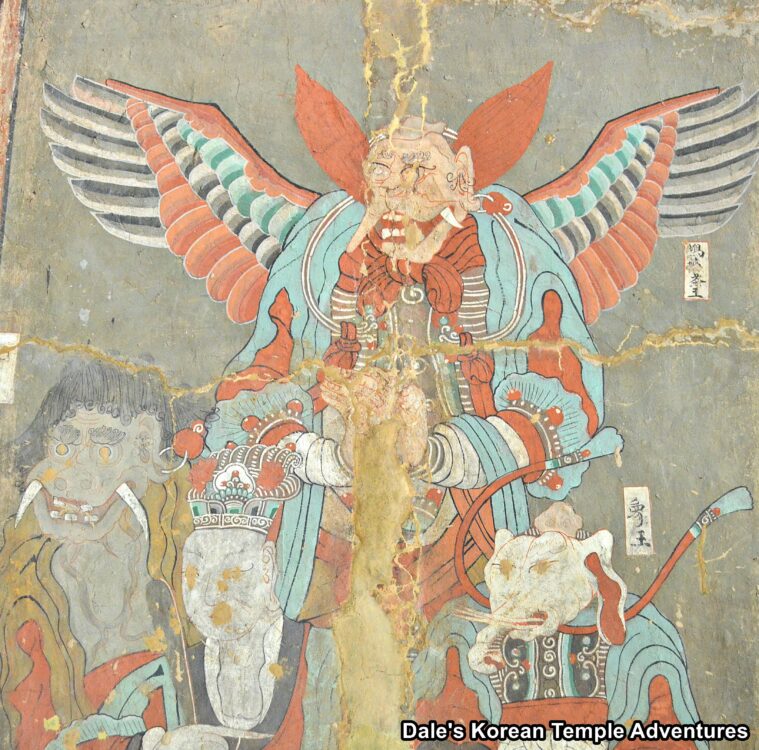
20. Infants Excrement Hungry Ghosts 伺嬰兒便鬼 蚩陀羅
Infants Excrement Hungry Ghosts (Ci Ying’er Bian, Chituoluo) are attracted to the excrement of infants, so they might linger around a baby’s crib. This type of Hungry Ghost specifically targets mothers who leave their baby too long in their own poop. So sometimes when an infant is crying, it’s believed to be caused by the ghostly presence of the Infants Excrement Hungry Ghost. These Hungry Ghosts also attack young children, frightening them or making attempts on their lives when the child is in a dangerous place or unsafe circumstances. Fortunately, these Hungry Ghosts are rarely successful, and that’s why they are tormented.
21. Desirable Appearance Hungry Ghosts 欲色鬼 迦摩
Desirable Appearance Hungry Ghosts can change their appearance to achieve their goals, so they can become attractive or repulsive at will. So depending on the situation, these Hungry Ghosts can become male, female, or even an animal. They can transform into a woman to lure men so that they can feed off of their energy or lust. They can also change their appearance to become a man so that they can steal food in homes for ceremonies. They can even change their form to appear like a bird so that they can fly and steal food offerings, as well. But again, they are usually unsuccessful, so that’s why they’re tormented as Hungry Ghosts.
Like Blood-Eating Hungry Ghosts, Desirable Appearance Hungry Ghosts are considered to be yakṣa (a broad class of nature-spirits, usually benevolent, but sometimes mischievous).
22. Islands Hungry Ghosts 海渚鬼 三牟陀羅提波
Islands Hungry Ghosts suffer from intense thirst and extreme environmental factors. Their food source is morning dew, which gives them relief. They also reside on uninhabited islands. And because they are stranded on a deserted island and exposed to the elements, they suffer from the heat without anything to quench their thirst. And on these uninhabited islands, and according to the Saddharmasmṛtyupasthānasūtra (Sūtra of the Foundations of Mindfulness of the True Law), one winter’s day is like ten times hotter than a summer’s day in the human world.
Physically, and like the Underworld Hungry Ghosts, Islands Hungry Ghost are emaciated and have disheveled hair. Their appearance is caused by their extreme thirst, which they are forced to continuously endure. And the reason for their karmatic rebirth is that they were people who profited by abusing others that were in difficult situations like travelers and refugees.
23. Assistants to the Underworld Kings Hungry Ghosts 閻羅王使執杖餓鬼
Assistants to the Underworld Kings Hungry Ghosts (Yanluowang Shi Zhizhang Egui), who are also known as Assistants of Yama Armed with Sticks, are Hungry Ghosts that manage other ghosts. Physically, these Hungry Ghosts have scrunched-up hair covering their faces. They also have elongated ears and big stomachs. But while they are assistants in the underworld, they too also suffer. People who tend to pray to these Hungry Ghosts are those that are on their deathbeds. As a result, these Hungry Ghosts linger between the human world and the underworld. These Hungry Ghosts are sent out into the world by Yama, who records the sinful acts committed by humans. They are also tasked with bringing sinners to Yama, where these Hungry Ghosts tell a human’s sins so that they can be judged.
24. Child-Eaters Hungry Ghosts 食小兒鬼 婆羅婆叉
Child-Eating Hungry Ghost (Shi Xiao’er, Poluopocha) are similar to Infants Excrement Hungry Ghosts. The major difference between the two, however, is that Child-Eating Hungry Ghosts are more malicious. They feed off the energy of infants; but fortunately, they are rarely successful, which adds to their torment. They are known to wander among humans to kidnap young children. Specifically, these Hungry Ghosts target children that can’t yet walk (so infants).
And the reason for their karmatic situation is that they were spiritual practitioners who abused their position towards sick people. Specifically, these Hungry Ghosts in their past lives promised to cure a sick person’s ailment by offering prayers in exchange for money or material gain.
25. Energy Eating Hungry Ghosts 食人精氣鬼 烏殊婆叉
Energy Eating Hungry Ghosts (Shi Ren Jingqi, Wushupocha) are the type of Hungry Ghosts that target people who are either physically ill or depressed. They typically lurk around critically ill people and feed off of their life energy. These Hungry Ghosts slowly creep into a person’s life and slowly absorbs their “vital energy.”
26. Brahmanic Rākṣasa Hungry Ghosts 梵羅剎鬼 婆羅門羅剎
Brahmanic Rākṣasa Hungry Ghosts (Fan Luosha, Boluomen Luosha) have supernatural powers. They are usually lost ghosts who haunt crossroads and back alleys. They lurk in these places waiting for the right opportunity to creep into a person’s body and possess them. And through misadventures or mishaps, they attempt to kill that person. And if they don’t possess a person, they can simply put a spell on them and take control of a person’s body.
The reason for this karmatic punishment is that it’s retribution for religious people who lost their way in their faith and become misguided and misguide others.
27. Hearth Hungry Ghosts 火爐鬼 君茶
Hearth Hungry Ghosts (Huolu, Juncha) lurk around the kitchens of religious places to steal their food. They can also feed themselves on temple leftovers mixed with coal. And the reason for this karmatic rebirth is that they were people who stole food from religious sites. So they took food offerings that were meant for monks or temples that were intended to feed the religious community.
28. Dirty Streets Hungry Ghosts 不淨巷陌鬼 阿輸婆囉他
Dirty Streets Hungry Ghost (Bujing, Xiangmo) lurk down dirty city and village streets at night. They lurk in places where immorality runs rampant and where streets are littered with both vomit and urine. In fact, they feed off of this vomit left behind by humans.
29. Wind-Eating Hungry Ghosts 食風鬼 婆移婆叉
Wind-Eating Hungry Ghosts (Shifeng, Poyipocha) are able to see food and drink; but when they reach for both or either, the food and drink are nothing more than an optical illusion. Instead, this food and drink is nothing more than the wind. These Hungry Ghosts are tormented by constant illusions that appear on the verge of finally being able to eat only to have this food or drink vanish.
This karmatic rebirth falls on people who make empty promises and donations to charity. They have also made false promises to monks, the poor, and/or the sick.
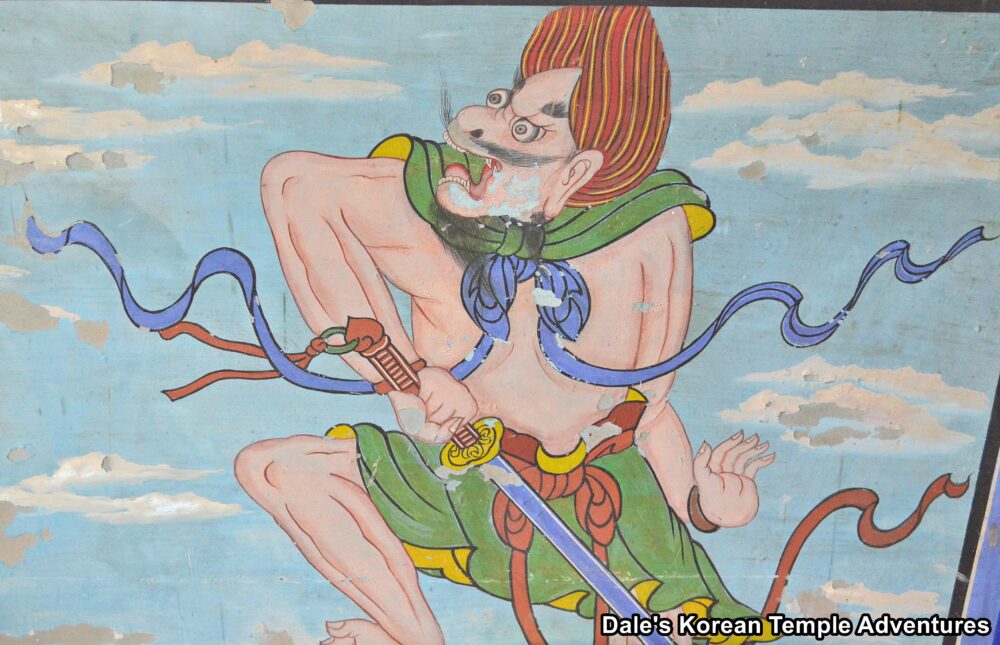
30. Coal-Eating Hungry Ghosts 食火炭鬼 鴦伽囉婆叉
Coal-Eating Hungry Ghosts (Shi Huotan, Yanggaluopocha) are those Hungry Ghosts that feed-off the ash created by cremation fires. These Hungry Ghosts wander through cemeteries to look for the remains of a cremated body. When they finally do eat the smoldering cremated ash, they feel a fleeting sense of wellness.
The reason for this karmatic retribution as Hungry Ghosts is that in their former lives, Coal-Eating Hungry Ghosts were in charge of prisons. And while in charge of these prisons, they allowed prisoners to suffer from hunger. In fact, for some of these prisoners, they were forced to eat mud just to stay alive. And when they are eventually reborn as humans, these Hungry Ghosts suffer the geographic disadvantage of living in a dangerous place.
31. Poison Eating Hungry Ghosts 食毒鬼 毘沙婆叉
Poison-Eating Hungry Ghosts (Shidu, Pishapocha) feed themselves off of poisonous fumes. They also feed off of toxic grass, which brings about their death; however, they are able to eventually to regain their lives only to suffer from hunger, once more. They live in caves with no drinking water or on mountains where the weather is either extremely hot or extremely cold. These mountains are typically populated by lions, tigers and/or birds that pluck out the eyes of the Hungry Ghosts. Also, and depending on the season, it can rain knives or flames from the sky.
And the reason as to why they suffer as a Hungry Ghost, in their former lives they poisoned someone to steal that person’s property.
32. Jungle Hungry Ghosts 曠野鬼 阿吒毘
Jungle Hungry Ghosts (Kuangye, Azhapi) roam the jungle looking for sources of food. They are driven in their quest for food by their intense hunger. While they are hunting in the jungle, they suffer from cuts from tree branches and thorns. They are also attacked by jungle animals and fierce jungle birds. And when they finally do arrive at their destination, they arrive in the wrong place.
And the reason for their karmatic punishment, and it’s a pretty specific one, is that of stealing. Typically in a deserted place, where virtuous men (people hoping for spiritual merit) plant trees and provide travelers with water, robbers steal the water from the local water supply. This leaves the travelers with no water, so they become thirsty and weak. And the reason they do all this is so that the robbers can steal the belongings of the travelers with even greater ease. This is perhaps the most specific of the karmatic punishments suffered by any of the thirty-six Hungry Ghosts.
33. Living in Cremation Grounds and Eating Hot Ashes Hungry Ghosts 塚間住食熱灰土 賒摩舍羅
The Living in Cremation Grounds and Eat Hot Ashes Hungry Ghosts (Zhongjian Zhu Shi Rehuitu, Shemosheluo) are doomed to carry objects on their body that resemble instruments of torture. More specifically, these Hungry Ghosts, because of the acts they committed in their former lives, carry around red-hot irons on their heads.
Now, as to why these Hungry Ghosts receive this specific karmatic rebirth, it’s because they stole offerings from religious sites like temples. One of these sins is that they might have stolen flowers offered to the Buddha by believers
34. Ghost Living in Trees Hungry Ghosts 樹中住鬼 毘利差
Ghost Living in Trees Hungry Ghosts are reborn and live inside trees. And they suffer the torment of those insects and animals that inhabit that tree. For example, insects munch away at these Hungry Ghosts. Also, they suffer from the weather that batters the tree. It’s believed that hermit monks that live in reclusive locations can be tormented by an entire forest of these Hungry Ghosts.
And the reason for this karmatic rebirth is because they have stolen wood belonging to a Buddhist community or temple. Very specifically, the Saddharmasmṛtyupasthānasūtra (Sūtra of the Foundations of Mindfulness of the True Law), the Zhengfa nianchu jing, states that a believer plants some trees for travelers and sick people only to have them cut down by the sinner to get some wood; and hence, their rebirth as a Ghost Living in Trees Hungry Ghosts.
35. Crossroads Hungry Ghosts 四交道 遮多波他
Crossroads Hungry Ghosts (Sijiao Dao, Zheduobota) specifically reside at crossroads. Uniquely, people make offerings to these Hungry Ghosts to help ward off mysterious ailments or difficulties at work. But by doing this, they ignore the law of karmic retribution worship. And the reason for this karmatic rebirth is because they have stolen food from travelers that are crossing through remote or deserted parts of the world.
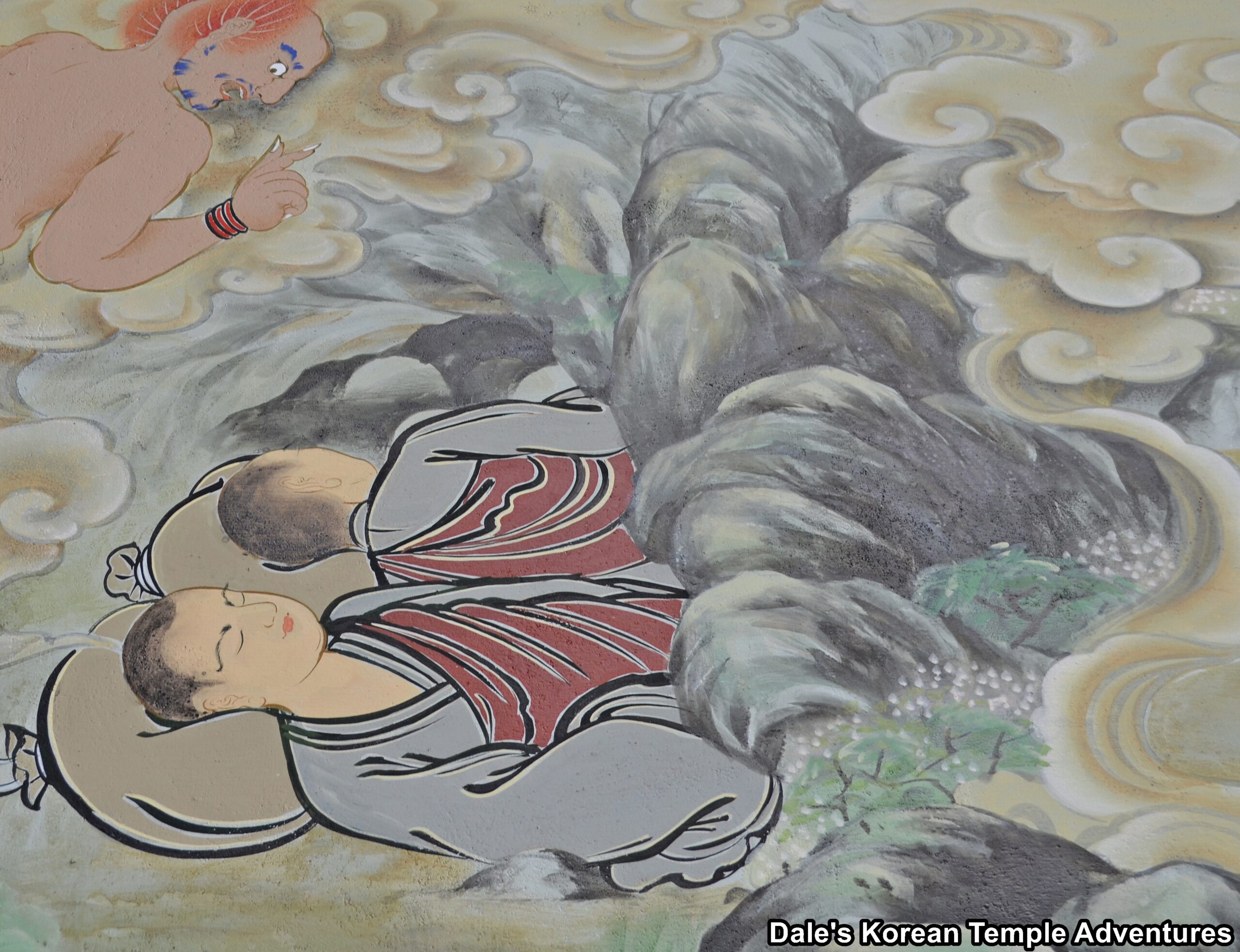
36. Māra-Body Hungry Ghosts 魔羅身鬼 魔羅迦耶
And the last of the Hungry Ghosts is the Mara-Body Hungry Ghost. These Hungry Ghost specifically target monks, nuns, and religious practitioners in their daily lives. These Hungry Ghosts feed-off of confusion that may arise from spiritual practices. As a result, these Hungry Ghosts enjoy bothering practitioners to help undermine their efforts. They do this by frightening religious people by making sinister sounds or appearing in their dreams. The very goal of the Mara-Body Hungry Ghost is to attack the Buddhist community; and hence, one of the most destructive of the Hungry Ghosts.
The karmatic rebirth was due to professing false doctrines. And when they are eventually reborn as humans, they suffer from birth defects, a short lifespan, poverty, accidents, and/or property loss.
Korean Buddhism and Hungry Ghosts (Agwi)
As to where you can typically find Hungry Ghosts at a Korean Buddhist temple, the most common place to find them is inside a Myeongbu-jeon Hall. Ceremonies are performed at Buddhist temples to help “feed” Agwi. They are held by people for their own deceased family members, or they can be held by monks for those spirits suffering as Hungry Ghosts in the afterlife. This ceremony is typically performed in front of a Gamno-do (Sweet Dew Mural). Typically, the ceremony involves chanting and the performance of Buddhist instruments like drums, bells, or cymbals in front of the Gamno-do to help comfort Agwi.
Great examples of Agwi can be found throughout various Korean Buddhist temples and/or hermitages. Here are just a few of these examples. The first is a 17th century Agwi mural inside the Daegwang-jeon Hall at Sinheungsa Temple in Yangsan, Gyeongsangnam-do. There are other historic murals of Agwi that can be found inside Gamno-do like at the National Museum of Korea in Seoul. There is also a beautiful collection of Siwang (The Ten Kings of the Underworld) in the museum at Girimsa Temple in eastern Gyeongju that have amazing images of Agwi. For more modern Gamno-do images, you can find them at Boseongsa Temple near Tongdosa Temple in Yangsan, Gyeongsangnam-do and Naewonam Hermitage near Unmunsa Temple in Cheongdo, Gyeongsangbuk-do. And finally, there are images of Agwi adorning both the interior and exterior walls of temple shrine halls like at Seongjusa Temple in Changwon, Gyeongsangnam-do and Nammireuksa Temple in Gangjin, Jeollanam-do. But Agwi are so prominent at Korean Buddhist temples, that if you look close enough, you’re sure to find a whole host of these Hungry Ghosts.
Conclusion
Hungry Ghosts are some of the most misunderstood images that are found in and around Korean Buddhist temples. Not only are they to be pitied (instead of feared), the very number of Hungry Ghosts found within the pantheon of Korean Buddhist images are misunderstood, as well. Hungry Ghosts often appear around temple shrine halls at Korean Buddhist temples especially in paintings. The most common place to find these desperate spirits is around the main hall and Myeongbu-jeon Hall especially the Gamno-do (Sweet Dew Mural). Typically you can find monks, nuns, or relatives making offerings to the dead to help pacify and aid these Hungry Ghosts. So the next time you’re at a Korean Buddhist temple or hermitage, have a look around for any one of the thirty-six Hungry Ghosts that are in constant torment. Not only are Hungry Ghosts a little scary, but they’re also meant to act as a warning and deterrent about your own misdeeds. So take stock and say a little prayer for these pitiful creatures at the next Korean Buddhist temple you visit.
